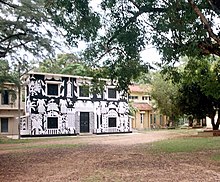
Shantiniketan is a neighbourhood of Bolpur town in the Bolpur subdivision of Birbhum district in West Bengal, India, approximately 152 km north of Kolkata. It was established by Maharshi Devendranath Tagore, and later expanded by his son, Rabindranath Tagore whose vision became what is now a university town with the creation of Visva-Bharati. It is also the birthplace of Amartya Sen, an Economist, Philosopher, & Nobel Laureate

Visva-Bharati, is a public central university and an Institute of National Importance located in Shantiniketan, West Bengal, India. It was founded by Rabindranath Tagore who called it Visva-Bharati, which means the communion of the world with India. Until independence it was a college. Soon after independence, the institution was given the status of a central university in 1951 by an act of the Parliament.

Nandalal Bose was one of the pioneers of modern Indian art and a key figure of Contextual Modernism.

The Inner Eye is a 1972 short documentary film made by Satyajit Ray on Benode Behari Mukherjee, a blind artist and a teacher from Visva-Bharati University, a university founded by Rabindranath Tagore at Santiniketan. The twenty minutes documentary features the life and works of Mukherjee in the form of paintings and photographs, starring himself. The documentary covers his journey from childhood till his blindness along with much of his works and features his words, "Blindness is a new feeling, a new experience, a new state of being". The documentary was awarded as Best Information Film (Documentary) at 20th National Film Awards in 1972.
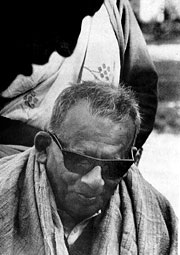
Benode Behari Mukherjee was an Indian artist from West Bengal state. Mukherjee was one of the pioneers of Indian modern art and a key figure of Contextual Modernism. He was one of the earliest artists in modern India to take up to murals as a mode of artistic expression. All his murals depict a subtle understanding of environmental through pioneering architectural nuances.
Ramkinkar Baij was an Indian sculptor and painter, one of the pioneers of modern Indian sculpture and a key figure of Contextual Modernism.
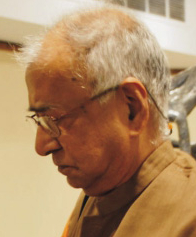
Kalpathi Ganpathi "K.G." Subramanyan was an Indian artist. He was awarded the Padma Vibhushan in 2012.
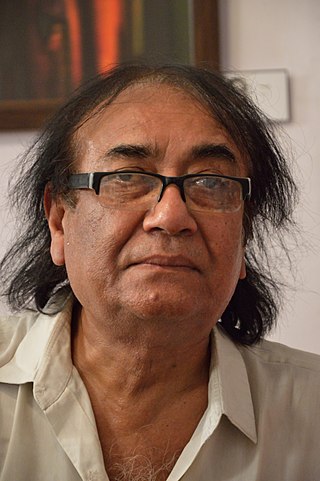
Jahar Dasgupta is a contemporary painter from India. He was born in Jamshedpur, British India.

The modern Indian art movement in Indian painting is considered to have begun in Calcutta in the late nineteenth century. The old traditions of painting had more or less died out in Bengal and new schools of art were started by the British. Initially, protagonists of Indian art such as Raja Ravi Varma drew on Western traditions and techniques including oil paint and easel painting. A reaction to the Western influence led to a revival in primitivism, called as the Bengal school of art, which drew from the rich cultural heritage of India. It was succeeded by the Santiniketan school, led by Rabindranath Tagore's harking back to idyllic rural folk and rural life. Despite its country-wide influence in the early years, the importance of the school declined by the 'forties' and now it is as good as dead.

Raman Siva Kumar, known as R. Siva Kumar, is an Indian contemporary art historian, art critic, and curator. His major research has been in the area of early Indian modernism with special focus on the Santiniketan School. He has written several important books, lectured widely on modern Indian art and contributed articles to prestigious international projects such as the Art Journal, Grove Art Online or The Dictionary of Art, Oxford University Press.

Suresh K. Nair is an artist based in Banaras. Nair obtained his national diploma in mural painting from the Institute of Mural Painting Guruvayur, Kerala under the guidance of Mammiyur Krishnan Kuty Nair. He was inspired by the works of Rabindranath Tagore, Nandalal Bose, Benode Behari Mukherjee and Ramkinker Baij and continued his studies at the Department of Painting, Visva Bharati University, Santiniketan. Nair has acquired a presence in the Indian and international art scene over the last decade with several shows organized by regional and international galleries and museums, and created many murals in India and abroad. His early works are based on Kerala murals, both in terms of technique and ideas. One of his modern paintings, ‘Cosmic Butterfly" is owned by Essl Museum, Vienna, Austria since 2010. His works were exhibited in the US, Spain, and Canada, and his awards include the Elizabath Green Shield Foundation Scholarship (1999) of Canada; Fulbright Fellowship ( 2006–07) for an Educational Exchange Program at Tyler School of Art, Temple University, Philadelphia under Professor Nicholas Kripal; and the State Award of Kerala Lalithkala Akademi, Ministry of Culture, Government of Kerala.
Santiniketan: The Making of a Contextual Modernism was an exhibition curated by R. Siva Kumar at the National Gallery of Modern Art in 1997, on the occasion of the 50th anniversary of India's Independence.
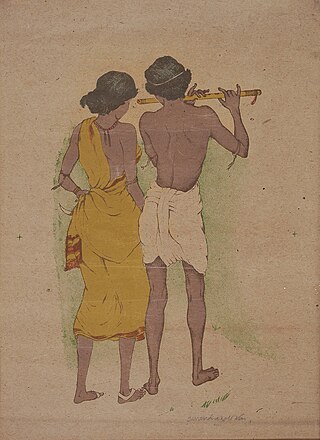
Surendranath Kar was an Indian artist and architect, known for amalgamating the Indian architectural style with western and eastern styles of architecture. Born in 1892 in British India, Kar did his primary learning of art under his cousin, renowned Bengali painter, Nandalal Bose, and Abanindranath Tagore, the nephew of Nobel Laureate, Rabindranath Tagore. Later, he joined Vichitra Club, founded by the Tagore family, as a teacher of art. In 1917, when Tagore set up Brahmacharyasrama, the precursor of later day Shantiniketan, he joined the institution and worked as an art teacher. Two years later, he moved to Kala Bhavana of Tagore as a faculty member.

Pratima Devi (1893–1969) was an Indian Bengali artist, widely known for her artistic abilities. She was the wife of Rathindranath Tagore. The poet took special interest in developing her capabilities.
Chitranibha Chowdhury was a twentieth-century Indian artist, a member of the Bengal School of Art, and one of the first female painters in Bengal. She created over a thousand artworks, including landscapes, still lifes, decorative art, murals, and portraits. She was a Nandalal Bose student and the first female painting teacher in Kala Bhavana, Shantiniketan. Her real name Nibhanani Bose was changed to Chitranibha Bose by Rabindranath Tagore.
The following is a list of notable people associated withVisva- Bharati University and/or Santiniketan, a neighbourhood in Bolpur city in West Bengal, India:

Cheena Bhavana, of Visva-Bharati University, founded in 1937, is a centre of Sino-Indian cultural studies located at Santiniketan in West Bengal, India. Its reputation as a center promoting historical study and modern relations between the two countries was built by such figures as Rabindranath Tagore and Tan Yun-Shan. The library is known for a major collection of Chinese books and journals, especially Buddhist scriptures and texts.
Dinkar Kowshik (1918-2011) was an influential Indian painter and educator. As principal of Kala Bhavana at Santiniketan, he reshaped it for contemporary art practices.

Jamuna Sen was an Indian artist, known for her design work in a variety of mediums including Batik and Alpona as well as developing, in an Indian context, a variety of traditional crafts from across the world. She was a pioneer in establishing the practice of Batik in India in modern times. Daughter of Nandalal Bose, a central figure in modern Indian art, she was brought up in the artistic and intellectual milieu of Santiniketan and made significant contributions in the field of design.
Gouri Bhanja (1907–1998) was an Indian artist best known for contributing to the original illuminated Constitution of India and for dedicating several decades of her life to teaching at Kala Bhavana. She was the eldest daughter of Nandalal Bose, master of Indian art.
